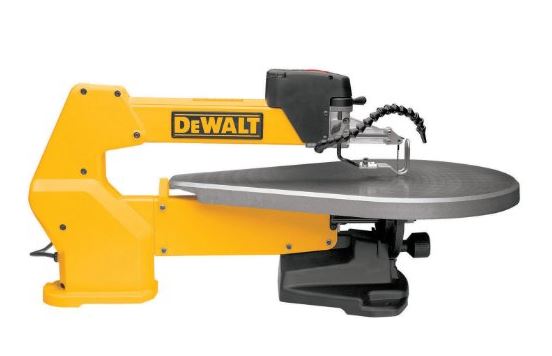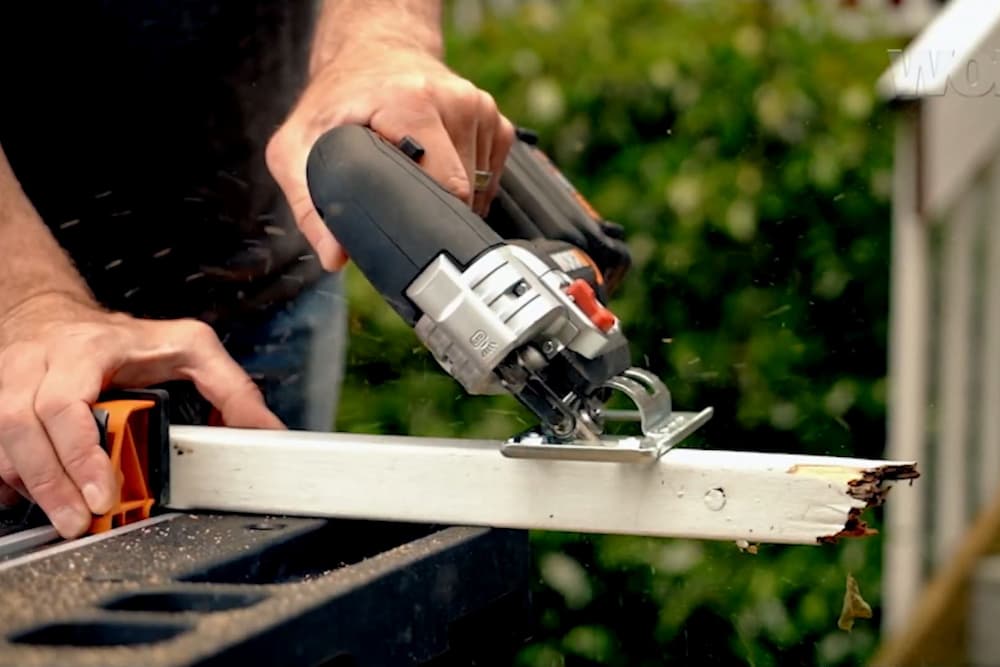Hello, fellow woodworking enthusiasts!
Today, I want to discuss a common question that I often encounter in my woodworking journey: “Should I use a scroll saw or a jigsaw for my project?”
As someone who has spent countless hours tinkering with both tools, I’m eager to share my insights with you to help you make the best decision.
In this blog post, we’ll dive into the world of scroll saws and jigsaws, exploring their unique features, advantages, and disadvantages.
I’ll also share my personal experiences and recommendations to help you choose the right tool for your specific needs. So, let’s get started and figure out which saw will be your go-to for your woodworking projects!
Scroll Saws: The Master of Intricate Cuts

Scroll saws are stationary tools that excel in creating intricate cuts and patterns in thin materials, such as wood, plastic, and metal. They have a fine, reciprocating blade that allows for precise control and clean edges, making them perfect for detailed work.
One of the biggest advantages of using a scroll saw like Dewalt DW788 is its incredible precision. When I work on projects that require detailed patterns or delicate fretwork, the scroll saw is my go-to tool. The level of control it offers is unmatched, allowing me to bring my most intricate designs to life. It also produces smoother edges, which means less sanding for me – a win in my book!
Another benefit of scroll saws is their ability to make internal cuts. By drilling a pilot hole and threading the blade through it, I can create intricate cutouts without needing to cut from the edge of the material. This feature is particularly handy for making decorative pieces or intricate wooden puzzles.
However, scroll saws do have some limitations. Their cutting capacity is generally limited to thinner materials, usually no more than 2 inches thick. This constraint means they might not be suitable for tackling hefty lumber or other thick materials. Additionally, because scroll saws are stationary, they’re less versatile compared to jigsaws, which offer portability and the ability to make cuts in a variety of positions.
In summary, scroll saws are fantastic tools for projects that demand precision, intricate patterns, and clean edges. However, their limited cutting capacity and lack of versatility may not make them the best fit for every woodworking scenario.
Jigsaws: The Jack of All Trades

Jigsaws are handheld power tools that can make both straight and curved cuts in a wide variety of materials, including wood, plastic, metal, and even ceramic tiles. I appreciate jigsaws for their versatility and portability – I can easily take them to different job sites or use them in tight spaces where a stationary tool would be impractical.
The main advantage of jigsaws is their adaptability. They can handle a broader range of tasks, from cutting plywood for a DIY project to trimming plastic sheets for a custom enclosure. Plus, they’re more portable, which can be a lifesaver when you’re short on space or working in an awkward position.
Another great feature of jigsaws is their ability to use different types of blades. By simply swapping out the blade, I can optimize my jigsaw for cutting various materials with ease. This flexibility is a huge bonus, as it allows me to tackle a wide array of projects without needing multiple saws.
On the downside, jigsaws tend to be less precise than scroll saws, and their cuts may require additional sanding for a smooth finish. The handheld nature of a jigsaw makes it more susceptible to slight deviations in cut lines, especially when working on intricate patterns. If you prioritize precision and intricate details, a jigsaw might not be your first choice.
In conclusion, jigsaws are the go-to tool for versatility and adaptability, capable of handling a diverse range of materials and cuts. However, if your project requires high levels of precision and intricate detailing, a scroll saw might be a better fit.
Factors to Consider When Choosing Between a Scroll Saw and a Jigsaw
Here are the main factors that will affect your choice of a saw.
Project Type and Complexity
Consider the level of detail and the type of cuts required for your project. If precision is key, a scroll saw is your friend. For general cutting tasks and versatility, a jigsaw might be a better fit. When I’m working on decorative pieces or complex designs, I always reach for my trusty scroll saw. But when I need to tackle a range of different cuts and materials, my jigsaw is the go-to tool.
Cutting Capacity
Keep in mind the thickness and types of materials you’ll be working with. Scroll saws are ideal for thinner materials, while jigsaws can handle a wider range of thicknesses. If your project involves cutting through thicker materials like hardwood or even metal, a jigsaw will likely be more suitable. On the other hand, if you’re primarily working with delicate materials or thin sheets, a scroll saw will be a better choice.
Budget
Jigsaws are generally more affordable than scroll saws. If you’re on a tight budget, a jigsaw might be the more economical option. When I first started woodworking, I found that a decent-quality jigsaw offered me a lot of bang for my buck. Over time, as I got more into intricate projects, I decided to invest in a scroll saw, but I still find my jigsaw indispensable for many tasks.
Workspace and Portability
Consider the space you have available and whether portability is essential. If you have limited space or need to move the tool around, a jigsaw might be the better choice. Scroll saws are stationary and require a dedicated workspace, whereas a jigsaw can be easily carried and used in various locations. For those with limited workshop space or who need to travel between job sites, a jigsaw offers the flexibility needed to get the job done.
By carefully considering these factors, you can make an informed decision about which tool is best suited to your specific needs and projects. Remember, it’s essential to choose the right tool for the job to ensure the best results and a more enjoyable woodworking experience.
My Personal Experiences and Recommendations
Throughout my woodworking journey, I’ve had the pleasure of working with both scroll saws and jigsaws, discovering their unique strengths and weaknesses along the way. Here, I’d like to share some of my personal experiences and recommendations to help you choose the right tool for your needs.
When Precision is Key: The Scroll Saw
In my experience, when I need precision and intricate cuts for projects like decorative pieces or wooden puzzles, I always reach for my trusty scroll saw. Its ability to create clean, detailed cuts with minimal sanding required is a game-changer for me. If your projects frequently involve complex patterns and delicate work, a scroll saw is an investment you won’t regret.
For Versatility and Flexibility: The Jigsaw
However, for a wider variety of tasks and greater flexibility, my jigsaw is indispensable. From cutting curves in plywood to trimming plastic sheets, the jigsaw handles a diverse range of materials and cuts with ease. Its portability makes it even more versatile, allowing me to work on projects both in my workshop and on job sites.
Trying Before Buying
Ultimately, the best tool for you depends on your specific needs and projects. If you’re unsure, consider borrowing or renting both tools to test them out before committing to a purchase. This hands-on approach will give you a better understanding of each tool’s capabilities and help you determine which one aligns best with your woodworking style and needs.
Don’t Forget the Blade Quality
One final tip: regardless of whether you choose a scroll saw or a jigsaw, always invest in high-quality blades. A good blade can significantly impact the performance of your tool and the quality of your cuts. Trust me, spending a little extra on top-notch blades will pay off in the long run.
Both scroll saws and jigsaws have their unique advantages and are valuable additions to any woodworking toolbox.
Conclusion
As with every tool, scroll saws and jigsaws each offer distinct advantages and disadvantages. Scroll saws excel in precision and intricate cuts, making them perfect for detailed and delicate projects. On the other hand, jigsaws shine in their versatility and portability, allowing you to tackle a broad range of materials and cuts in various locations.
When choosing the right tool for your project, consider factors such as project type and complexity, cutting capacity, budget, and workspace constraints. Think about the specific needs of your woodworking projects and how each tool’s strengths and weaknesses align with those requirements.
In my own woodworking journey, I’ve found that having both a scroll saw and a jigsaw in my arsenal has been invaluable. By carefully considering your needs and priorities, you can select the tool that will best support your woodworking endeavors, helping you achieve professional results and enjoy a satisfying woodworking experience.
As always, feel free to experiment, learn, and grow in your woodworking skills. And remember, the right tool for the job can make all the difference. Happy woodworking, my friends!

